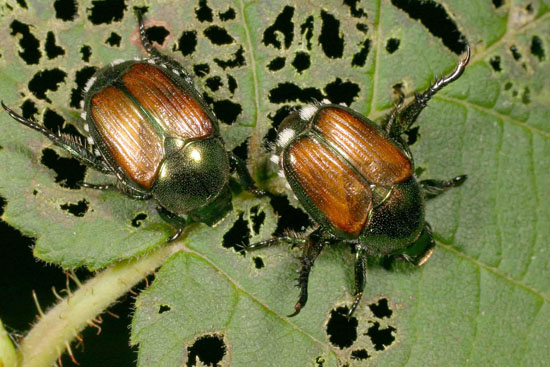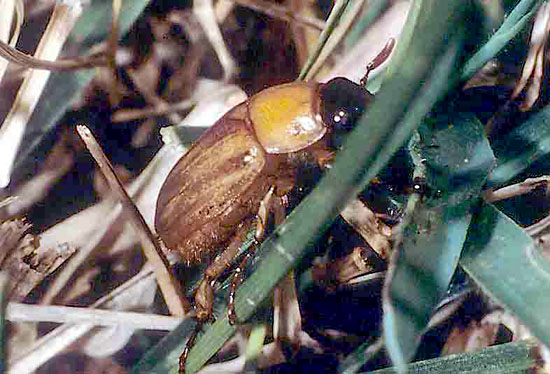Issue 10, July 5, 2017
White Grubs
This is a good time to observe the abundance and activity of white grub adults. This knowledge along with rainfall patterns is useful in making treatment decisions over the coming months.
Japanese beetle and masked chafer adults primarily lay their eggs during the first two weeks of July in central and northern Illinois. Egg-laying is finishing in southern Illinois, making this a good time to write some notes about this year's adult numbers and weather conditions.
Adult Japanese beetles are 1/2-inch-long, heavy-bodied, oval beetles that are metallic green, with coppery wing covers. Visible along the sides of the body below the wing covers is a series of white spots formed by clumps of white hair. There are two similar spots of white hair below the wing covers on the rear end of the beetle. The beetles fly when disturbed, making a buzzing sound.

Japanese beetle adults.
They feed as adults during daylight hours on a wide range of plants, preferring smartweed, grape, raspberry, rose, crabapple, and linden. They skeletonize leaves, feeding from the upper side of the leaf, leaving only the veins. Mating occurs in early morning and early evening, and the female burrows into the soil to lay her eggs. The adults hide in the soil from late evening through the night, remaining in the soil on cold, wet days. The adult beetles live for 4 to 6 weeks.
Masked chafer larvae are commonly called annual white grubs. There are two species that are common, and the southern masked chafer is more common in the state than the northern masked chafer. Adults are small, 1/2-inch-long June beetles that are tan, with a black marking or mask on the head. They do not feed, and a population of adults is present in an area for 2 to 3 weeks.

Masked chafer adult.
After hiding in the soil and thatch during the day, they emerge to mate and lay eggs at night, mostly from 10 p.m. to midnight. They are strongly attracted to lights at night, making it easy to know when they are active. They can be easily detected by shining cart, car, or other vehicle lights across the turf, illuminating their mating flights.
Rainfall is the dominant factor associated with white grub abundance in Illinois in most years. Adult Japanese beetles and masked chafers are attracted to moist soil with green turf to lay their eggs which hatch into white grubs by early August. If non-irrigated turf is dry and brownish, the beetles fly to moist, green, irrigated areas to lay their eggs, resulting in high grub numbers in those areas. If non-irrigated soil is moist, the beetles will lay their eggs in most turf areas, typically resulting in few white grubs per square foot usually not requiring treatment. (Phil Nixon)
Author:
Phil Nixon